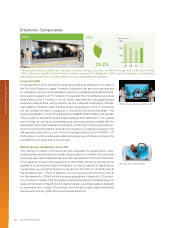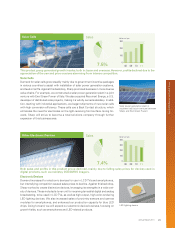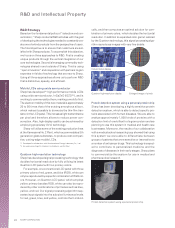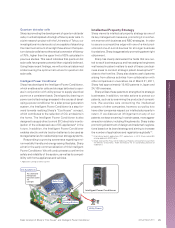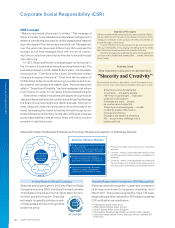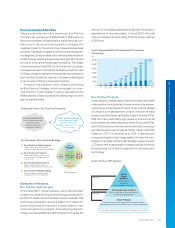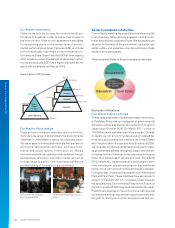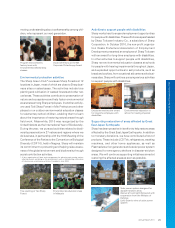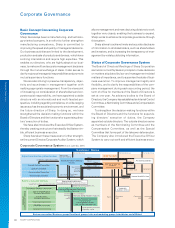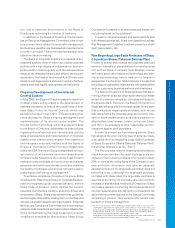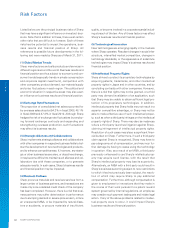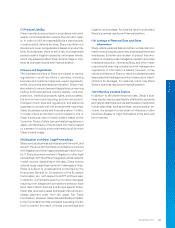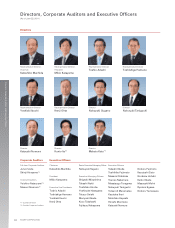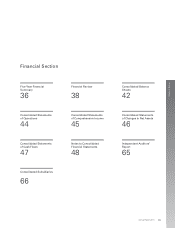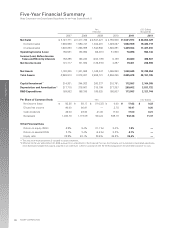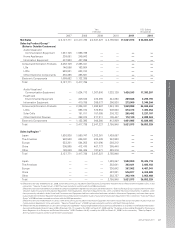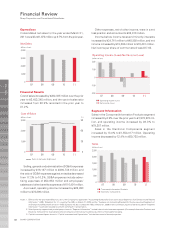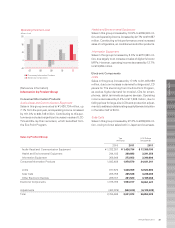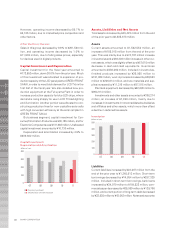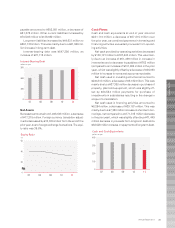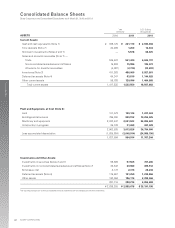Sharp 2011 Annual Report Download - page 34
Download and view the complete annual report
Please find page 34 of the 2011 Sharp annual report below. You can navigate through the pages in the report by either clicking on the pages listed below, or by using the keyword search tool below to find specific information within the annual report.
32 SHARP CORPORATION
Risk Factors
Risk Factors
Listed below are the principal business risks of Sharp
that may have a significant influence on investors’ deci-
sions. Note that in addition to these, there exist certain
other risks that are difficult to foresee. Each of these
risks has the potential to impact the operations, busi-
ness results and financial position of Sharp. All
references to possible future developments in the fol-
lowing text were made by Sharp as of March 31, 2011.
(1) Global Market Trends
Sharp manufactures and sells products and services in
different regions around the world. Business results and
financial position are thus subject to economic and con-
sumer trends (especially trends in private consumption
and corporate capital investment), competition with
other companies, product demand, raw material supply
and price fluctuations in each region. The political and
economic situation in respective areas may also exert
an influence on business results and financial position.
(2) Exchange Rate Fluctuations
The proportion of consolidated net sales accounted for
by overseas sales stood at 54.3% in fiscal 2008, 48.1%
in fiscal 2009 and 47.3% in fiscal 2010. Although Sharp
hedges the risk of exchange rate fluctuations by employ-
ing forward exchange contracts and expanding and
strengthening overseas production, such fluctuations
may affect its business results.
(3) Strategic Alliances and Collaborations
Sharp implements strategic alliances and collaborations
with other companies in respective business fields to bol-
ster the development of new technologies and products,
and to enhance competitiveness. If, however, any strate-
gic or other business issues arise, or objectives change,
it may become difficult to maintain such alliances and col-
laborative ties with these companies, or to generate
adequate results. In such cases, Sharp’s business results
and financial position may be impacted.
(4) Business Partners
Sharp procures materials and receives services from a
large number of business partners, and transactions are
made only once a detailed credit check of the company
has been completed. However, there is a risk that busi-
ness partners may suffer deterioration in performance
due to slumping demand or severe price erosion, or face
an unexpected M&A, or be impacted by natural disas-
ters or accidents, or procure materials of insufficient
quality, or become involved in a corporate scandal includ-
ing a breach of the law. Any of these factors may affect
Sharp’s business results and financial position.
(5) Technological Innovation
New technologies are emerging rapidly in the markets
where Sharp operates. Resultant changes in social infra-
structure, intensified market competition, changes in
technology standards, or the appearance of substitute
technologies may impact Sharp’s business results and
financial position.
(6) Intellectual Property Rights
Sharp strives to protect its proprietary technologies by
acquiring patents, trademarks, and other intellectual
property rights in Japan and in other countries, and by
concluding contracts with other companies. However,
there is a risk that rights may not be granted, or a third
party may demand invalidation of an application, such
that Sharp may be unable to obtain sufficient legal pro-
tection of its proprietary technologies. In addition,
intellectual property that Sharp holds may not result in a
superior competitive advantage, or Sharp may not be
able to make effective use of such intellectual proper-
ty, such as when a third party infringes on the intellectual
property rights of Sharp. There may also be instances
where a third party launches litigation against Sharp,
claiming infringement of intellectual property rights.
Resolution of such cases may place a significant finan-
cial burden on Sharp. Furthermore, if such a third-party
claim against Sharp is recognized, Sharp may have to
pay a large amount of compensation, and may incur fur-
ther damage by having to cease using the technology
in question. Also, as a result of an M&A, a third party
previously unlicensed to use Sharp’s intellectual prop-
erty may acquire such license, with the result that
Sharp’s intellectual property may lose its superiority.
Alternatively, an M&A with a third party could result in
Sharp’s business becoming subject to new restrictions
to which it had not previously been subject, the resolu-
tion of which may require Sharp to pay additional
compensation. Furthermore, although compensation is
given to employees for innovations that they make in
the course of their work pursuant to a patent reward
system governed by internal regulations, an employee
may consider such payment inadequate and initiate legal
action. If any of the above problems related to intellec-
tual property were to occur, it could impact Sharp’s
business results and financial position.


